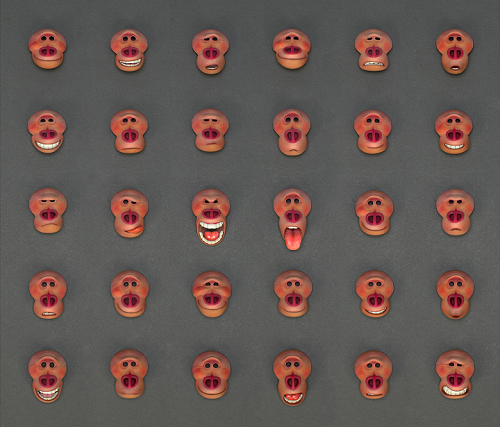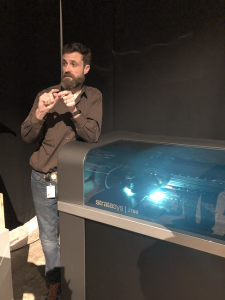Just a few short days ago, the latest stop-motion animation film from Oregon-based LAIKA Studio, Missing Link, opened in US theaters, with the theatrical release in Germany coming next month. I have been eagerly awaiting the release, not just because the movie – the studio’s fifth – looks really interesting, but because I was lucky enough to get a behind-the-scenes look into the studio’s film-making process on a trip to LAIKA last month. Starring the voice talents of such actors as Hugh Jackman, Zoe Saldana, and Zach Galifianakis, the movie was described by its writer and director Chris Butler as a combination of Indiana Jones, Sherlock Holmes, and Around the World in 80 Days with monsters, and was LAIKA’s “most ambitious film to date.”
While at the Portland studio, Brian McLean, LAIKA’s Director of Rapid Prototyping and the recipient of a Scientific and Engineering Oscar plaque for his work, spoke to our small group about the studio’s use of 3D printing to make over 106,000 snap-on faces for the film’s stop-motion animation characters. While this certainly isn’t LAIKA’s first time using 3D printing, Missing Link is its first film to feature bespoke facial animation, as well as the first to rely solely on the Stratasys multi-material J750 3D printer for its characters’ faces, which were designed using MAYA software and easily snap on and off with coded magnets.
In fact, LAIKA was so excited about the J750 that it was actually a beta user for the 3D printer, and later bought “the first five off the assembly line.” But it wasn’t a perfect solution just yet.“…we saw this technology, we thought it was where the industry was going, and we got a few of the printers in,” McLean told us during the LAIKA tour.
“The hardware that Stratasys had created was really cool, but the software was really limiting, and we ended up partnering with an independent software developer that allowed us to do this really advanced color placement with resin placement.”
This is where LAIKA happened upon another first – this is its first stop-motion feature to use the patented Cuttlefish 3D printer driver, developed by the Fraunhofer Institute for Computer Graphics Research IGD.
McLean explained to us that after a conference presentation on its 2014 film The BoxTrolls, a LAIKA employee ended up sitting next to a representative from the Fraunhofer research organization, who mentioned the organization’s Cuttlefish advanced slicer software. According to the website, the voxel-based Cuttlefish driver is universal, meaning it can control diverse 3D printers, “allowing high-fidelity reproduction of an object’s appearance in addition to its shape and more.”

Mr. Link’s different faces and emotions were 3D printed with Fraunhofer IGD’s Cuttlefish technology. [Image: LAIKA]
“We have used 3D printers for our stop-motion movies since Coraline, LAIKA’s first film. For our current production Missing Link, we leveraged Fraunhofer IGD technologies because they are unrivalled in terms of color consistency and geometric accuracy,” McLean said in a press release. “The combination of Cuttlefish software and Stratasys J750 hardware has allowed us to produce the most sophisticated colored 3D prints ever.”
 Fraunhofer IGD was founded 30 years ago, and is a leading institution for applied research in the field of visual computing. Cuttlefish allows for simultaneous work with multiple 3D printing materials, including translucent ones, and makes it possible for objects to be simulated onscreen before they are printed. The driver ensures accurate, high fidelity reproduction of an object’s colors, shapes, and subtle transitions, as it “accounts for the dispersion of light through the object.”
Fraunhofer IGD was founded 30 years ago, and is a leading institution for applied research in the field of visual computing. Cuttlefish allows for simultaneous work with multiple 3D printing materials, including translucent ones, and makes it possible for objects to be simulated onscreen before they are printed. The driver ensures accurate, high fidelity reproduction of an object’s colors, shapes, and subtle transitions, as it “accounts for the dispersion of light through the object.”
As the capabilities of 3D printers continue to grow, the potential challenges software has to get past do as well. For instance, it takes a whole lot of data to position input material so that it accurately reproduces geometric and visual attributes; that’s why Cuttlefish supports streaming, which reduces how much memory is needed for this task. This means large and complex 3D models can begin printing very quickly.

In stop-motion animation, physical models are minimally manipulated between frames – 24 make up one second of the film. [Image: LAIKA]
“So we were able to leverage the research that Fraunhofer had done, combine it with the hardware that Stratasys had created, and during the production of ‘Missing Link,’ we were able to produce 3D color printed faces that literally no one else in the world had the sophistication to do,” McLean told us during the LAIKA studio tour.
In addition to the film industry, there are many other possible applications for this kind of high-fidelity 3D printing, such as automotive engineering, cultural heritage, and medicine, and it’s ever more important in fabricating end-products, prototypes, and highly accurate replicas.
Discuss this story and other 3D printing topics at 3DPrintBoard.com or share your thoughts in the Facebook comments below.
Subscribe to Our Email Newsletter
Stay up-to-date on all the latest news from the 3D printing industry and receive information and offers from third party vendors.
You May Also Like
3D Printing Financials: Fathom Struggles in Financial Quicksand During Critical Transition
Facing a year of key transitions and financial pressures, Fathom (Nasdaq: FTHM) has filed its annual report for 2023 with the U.S. Securities and Exchange Commission (SEC). The document outlines...
Latest Earnings Overview for Australian 3D Printing Firms Titomic and AML3D
Australian 3D printing manufacturing firms Titomic (ASX: TTT) and AML3D (ASX: AL3) reported their financial results for the period from July to December 2023, marking the first half of their...
3D Printing Webinar and Event Roundup: April 7, 2024
Webinars and events in the 3D printing industry are picking back up this week! Sea-Air-Space is coming to Maryland, and SAE International is sponsoring a 3D Systems webinar about 3D...
3D Printing Financials: Unpacking Farsoon and BLT’s 2023 Performance
In the Chinese 3D printing industry, two companies, Farsoon (SHA: 688433) and Bright Laser Technologies, or BLT (SHA: 688333), have recently unveiled their full-year earnings for 2023. Farsoon reported increases...


































